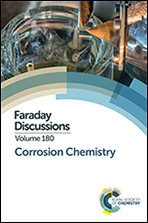A mechanistic model for oxide growth and dissolution during corrosion of Cr-containing alloys†
Abstract
We have developed a corrosion model that can predict metal oxide growth and dissolution rates as a function of time for a range of solution conditions. Our model considers electrochemical reactions at the metal/oxide and oxide/solution interfaces, and the metal cation flux from the metal to the solution phase through a growing oxide layer, and formulates the key processes using classical chemical reaction rate or flux equations. The model imposes mass and charge balance and hence, is labeled as the Mass Charge Balance (MCB) model. Mass and charge balance dictate that at any given time the oxidation (or metal cation) flux must be equal to the sum of the oxide growth flux and the dissolution flux. For each redox reaction leading to the formation of a specific oxide, the metal oxidation flux is formulated using a modified Butler–Volmer equation with an oxide-thickness-dependent effective overpotential. The oxide growth and dissolution fluxes have a first-order dependence on the metal cation flux. The rate constant for oxide formation also follows an Arrhenius dependence on the potential drop across the oxide layer and hence decreases exponentially with oxide thickness. This model is able to predict the time-dependent potentiostatic corrosion behaviour of both pure iron, and Co–Cr and Fe–Ni–Cr alloys.
- This article is part of the themed collection: Corrosion Chemistry

 Please wait while we load your content...
Please wait while we load your content...